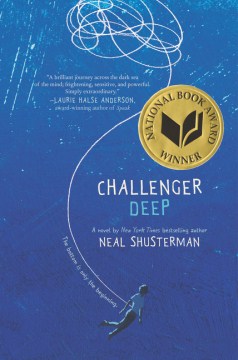Challenger Deep by Neal Shusterman
“‘But dreams give you insight,’ I point out.
“The captain leans closer, the acrid smoke of his pipe stinging my eyes. ‘Not these dreams.’”
Fifteen-year-old Caden Bosch is sure that someone at school is trying to kill him. When he finally opens up to his father about the situation, the details aren’t just sketchy–they don’t exist. The other boy is just someone walking the halls of school. He doesn’t know Caden and has no reason to hurt him. Caden’s father hopes that after their talk, he will feel better. Caden pretends to be better; he stays out walking for hours in an effort to make his parents believe he is on the school’s cross-country team.However, Caden’s good friends Max and Shelby are aware that he is not himself. For two years they’ve been designing a computer RPG. Caden is responsible for the graphics, but they now see his work as sloppy; he sees his work as failing because he can’t keep up with his vision.
Caden allows readers some of his secrets, things that neither his parents nor his friends would understand: the sprinklers in the yard sound like the hiss of snakes, the dolphins he painted on his sister’s bedroom walls are plotting deadly scheme, he feels termites eating the wood of the house. He can’t sleep as he wrestles with what is real and what is not. “Holding these two incompatible truths together takes skill at juggling.”
And always lurking under all the effort at restraint is the captain, the parrot, the ship, and the journey to Challenger Deep, the deepest point in the deepest trench on earth, entirely under the sea. The ship’s navigator tells Caden that he is the compass, that his visions show the way the ship must travel.
Caden is schizophrenic, and those around him are just coming to terms with this. He is hospitalized and is given a cocktail of powerful drugs, one that must be monitored and altered until he can stop hallucinating.
While at first, the novel moves into and out of reality without transitions, once Caden is in the hospital, it becomes clear that his adventures at sea have direct correlations in life–that is, the ship’s figurehead, Calliope, the navigator, the swabby–all have parallels in Caden’s life. The crow’s nest and its vast cocktail bar is full of meaning. Caden thinks “I conclude that it would be a good place to be alone with my thoughts, but I should already know that my thoughts are never alone.”
At the story’s satisfying end, author Neal Shusterman tells readers that his own son Brendan has experience with mental illness, experience that the author is trying to bring to life. He succeeds mightily. Brendan Shusterman, Neal’s son, is the novel’s illustrator. All of the work included was “drawn in the depths.” Brendan’s work adds much to the novel’s sense of exploring an unknown world.
The novel’s extended metaphor of sea navigation representing the exploration of the depths of a human mind is truly wonderful. But I also enjoyed a paragraph that compared life to creating on the potter’s wheel :
Centering, however, is easier said than done. This I learned from a ceramics class I once took. The teacher made throwing a pot look easy, but the thing is, it takes lots of precision and skill. You slam the ball of clay down in the absolute center of the pottery wheel, and with steady hands you push your thumb into the middle of it, spreading it wider a fraction of an inch at a time. But every single time I tried to do it, I only got so far before my pot warped out of balance, and every attempt to fix it just made it worse, until the lip shredded, the sides collapsed, and I was left with what the teachers called “a mystery ashtray,’ which got hurled back into the clay bucket.
No matter our mental stability–we’ve all made ‘mystery ashtrays’ out of life situations. So, we can empathize with the truly dark and difficult stretches of Caden’s path, exponentially worse that what we may have experienced. It is this relatability that makes Challenger Deep shine.
High school housekeeping: While the reading level of Challenge Deep is not difficult, it does take on the very serious issue of mental illness, particularly schizophrenia. Since we are in the mind of Caden Bosch, we must, with him, sort through reality and illusion. Early on, when there are no transitions, this may make the reading more difficult for the reluctant reader. However, with all of Caden’s high-seas adventure, even the reluctant reader may quickly dive into Caden’s world. Challenger Deep won the National Book Award. All readers will recognize that Shusterman is an excellent writer worthy of the honor and that his weaving of reality and illusion is highly skilled. This is a not-to-be-missed book.
If you are a teen who hasn’t had the chance to see the work of the artist Hieronymous Bosch, look it up. While Caden doesn’t want to think of himself as a participant in the strangely nightmare world of Bosch, there’s a reason the author has given the protagonist the same last name.

Pingback: Attending Author Events: George Saunders - Victoria Waddle
Pingback: One Important Secret in 'Far from the Tree' - Victoria Waddle
Pingback: One Important Secret: Balance. Character, Emotion, and Story in Far from the Tree | School Library Lady
Pingback: Reading for Renewal: Book Recommendations - Victoria Waddle